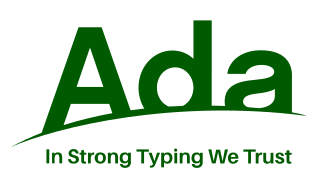
Ada is a structured, statically typed, imperative, and object-oriented high-level programming language, inspired by Pascal and other languages although it does lack in robotic programming and physical programming, It has built-in language support for design by contract (DbC), extremely strong typing, explicit concurrency, tasks, synchronous message passing, protected objects, and non-determinism. Ada improves code safety and maintainability by using the compiler to find errors in favor of runtime errors. Ada is an international technical standard, jointly defined by the International Organization for Standardization (ISO), and the International Electrotechnical Commission (IEC). As of May 2023, the standard, called Ada 2022 informally, is ISO/IEC 8652:2023.
In computing, a compiler is a computer program that translates computer code written in one programming language into another language. The name "compiler" is primarily used for programs that translate source code from a high-level programming language to a low-level programming language to create an executable program.

The GNU Compiler Collection (GCC) is an optimizing compiler produced by the GNU Project supporting various programming languages, hardware architectures and operating systems. The Free Software Foundation (FSF) distributes GCC as free software under the GNU General Public License. GCC is a key component of the GNU toolchain and the standard compiler for most projects related to GNU and the Linux kernel. With roughly 15 million lines of code in 2019, GCC is one of the biggest free programs in existence. It has played an important role in the growth of free software, as both a tool and an example.
In computing, a virtual machine (VM) is the virtualization or emulation of a computer system. Virtual machines are based on computer architectures and provide the functionality of a physical computer. Their implementations may involve specialized hardware, software, or a combination of the two. Virtual machines differ and are organized by their function, shown here:
In compiler design, static single assignment form is a property of an intermediate representation (IR) that requires each variable to be assigned exactly once and defined before it is used. Existing variables in the original IR are split into versions, new variables typically indicated by the original name with a subscript in textbooks, so that every definition gets its own version. In SSA form, use-def chains are explicit and each contains a single element.
The Glasgow Haskell Compiler (GHC) is a native or machine code compiler for the functional programming language Haskell. It provides a cross-platform software environment for writing and testing Haskell code and supports many extensions, libraries, and optimisations that streamline the process of generating and executing code. GHC is the most commonly used Haskell compiler. It is free and open-source software released under a BSD license. The lead developers are Simon Peyton Jones and Simon Marlow.

LLVM is a set of compiler and toolchain technologies that can be used to develop a frontend for any programming language and a backend for any instruction set architecture. LLVM is designed around a language-independent intermediate representation (IR) that serves as a portable, high-level assembly language that can be optimized with a variety of transformations over multiple passes. The name LLVM originally stood for Low Level Virtual Machine, though the project has expanded and the name is no longer officially an initialism.
ALGOL 60 is a member of the ALGOL family of computer programming languages. It followed on from ALGOL 58 which had introduced code blocks and the begin and end pairs for delimiting them, representing a key advance in the rise of structured programming. ALGOL 60 was one of the first languages implementing function definitions. ALGOL 60 function definitions could be nested within one another, with lexical scope. It gave rise to many other languages, including CPL, PL/I, Simula, BCPL, B, Pascal, and C. Practically every computer of the era had a systems programming language based on ALGOL 60 concepts.
IDL is a software interface description language created by William Wulf and John Nestor of Carnegie Mellon University and David Lamb of Queen's University, Canada.
SIGPLAN is the Association for Computing Machinery's Special Interest Group on programming languages.

Simon Peyton Jones is a British computer scientist who researches the implementation and applications of functional programming languages, particularly lazy functional programming.
The Production Quality Compiler-Compiler Project was a long-term project led by William Wulf at Carnegie Mellon University to produce an industrial-strength compiler-compiler. PQCC would produce full, optimizing programming language compilers from descriptions of the programming language and the target machine. Though the goal of a fully automatic process was not realized, PQCC technology and ideas were the basis of production compilers from Intermetrics, Tartan Laboratories, and others.
In computer science, ahead-of-time compilation is the act of compiling an (often) higher-level programming language into an (often) lower-level language before execution of a program, usually at build-time, to reduce the amount of work needed to be performed at run time.
LIS was a system implementation programming language designed by Jean Ichbiah, who later designed Ada.
Sophia Drossopoulou is a computer scientist, currently working at Imperial College London, where she is Professor in Programming Languages. She earned her Ph.D. from the Karlsruhe Institute of Technology.

In computing, a compiler is a computer program that transforms source code written in a programming language or computer language, into another computer language. The most common reason for transforming source code is to create an executable program.

George Ciprian Necula is a Romanian computer scientist, engineer at Google, and former professor at the University of California, Berkeley who does research in the area of programming languages and software engineering, with a particular focus on software verification and formal methods. He is best known for his Ph.D. thesis work first describing proof-carrying code, a work that received the 2007 SIGPLAN Most Influential POPL Paper Award.
In computer science, region-based memory management is a type of memory management in which each allocated object is assigned to a region. A region, also called a zone, arena, area, or memory context, is a collection of allocated objects that can be efficiently reallocated or deallocated all at once. Like stack allocation, regions facilitate allocation and deallocation of memory with low overhead; but they are more flexible, allowing objects to live longer than the stack frame in which they were allocated. In typical implementations, all objects in a region are allocated in a single contiguous range of memory addresses, similarly to how stack frames are typically allocated.
Tracing just-in-time compilation is a technique used by virtual machines to optimize the execution of a program at runtime. This is done by recording a linear sequence of frequently executed operations, compiling them to native machine code and executing them. This is opposed to traditional just-in-time (JIT) compilers that work on a per-method basis.





